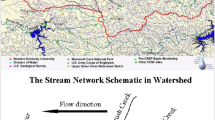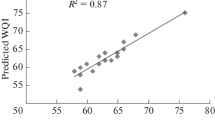Abstract
Poor water quality is a serious problem in the world which threatens human health, ecosystems, and plant/animal life. Prediction of surface water quality is a main concern in water resource and environmental systems. In this research, the support vector machine and two methods of artificial neural networks (ANNs), namely feed forward back propagation (FFBP) and radial basis function (RBF), were used to predict the water quality index (WQI) in a free constructed wetland. Seventeen points of the wetland were monitored twice a month over a period of 14 months, and an extensive dataset was collected for 11 water quality variables. A detailed comparison of the overall performance showed that prediction of the support vector machine (SVM) model with coefficient of correlation (R 2) = 0.9984 and mean absolute error (MAE) = 0.0052 was either better or comparable with neural networks. This research highlights that the SVM and FFBP can be successfully employed for the prediction of water quality in a free surface constructed wetland environment. These methods simplify the calculation of the WQI and reduce substantial efforts and time by optimizing the computations.






Similar content being viewed by others
References
Bateni SM, Borghei SM, Jeng DS (2007) Neural network and neuro-fuzzy assessments for scour depth around bridge piers. Eng Appl Artif Intell 20:401–414
Betbeder J, Rapinel S, Corpetti T, Pottier E, Corgne S & Hubert-Moy L (2013) Multi-temporal classification of TerraSAR-X data for wetland vegetation mapping. Proc SPIE Int Soc Opt Eng
Brix H (1997) Do macrophytes play a role in constructed treatment wetlands? Water Sci Technol 35:11–17
Chang C-C, Lin C-J (2011) LIBSVM: a library for support vector machines. ACM Trans Intell Syst Technol 2:27
Chen S-T, Yu P-S (2007) Real-time probabilistic forecasting of flood stages. J Hydrol 340:63–77
Dadaser-Celik F, Cengiz E (2013) A neural network model for simulation of water levels at the Sultan Marshes wetland in Turkey. Wetl Ecol Manag 21:297–306
Department of Environment. Malaysia Environmental Quality Report (2005) Department of Environment, Ministry of Natural Resources and Environment, Petaling Jaya, Malaysia
Diamantopoulou MJ, Antonopoulos VZ, Papamichail DM (2005) The use of a neural network technique for the prediction of water quality parameters of Axios River in Northern Greece. J Oper Res, Springer-Verlag, 115–125
Dong Y, Scholz M, Harrington R (2012) Statistical modeling of contaminants removal in mature integrated constructed wetland sediments. J Environ Eng (United States) 138:1009–1017
Dronova I, Gong P, Clinton NE, Wang L, Fu W, Qi S, Liu Y (2012) Landscape analysis of wetland plant functional types: the effects of image segmentation scale, vegetation classes and classification methods. Remote Sens Environ 127:357–369
Espejo L, Kretschmer N, Oyarzún J, Meza F, Núñez J, Maturana H, Soto G, Oyarzo P, Garrido M, Suckel F, Amezaga J, Oyarzún R (2012) Application of water quality indices and analysis of the surface water quality monitoring network in semiarid North-Central Chile. Environ Monit Assess 184:5571–5588
Gazzaz NM, Yusoff MK, Aris AZ, Juahir H, Ramli MF (2012) Artificial neural network modeling of the water quality index for Kinta River (Malaysia) using water quality variables as predictors. Mar Pollut Bull 64:2409–2420
Ghani AA, Azamathulla HM (2014) Development of GEP-based functional relationship for sediment transport in tropical rivers. Neural Comput & Applic 24:271–276
Guardo M (1999) Hydrologic balance for a subtropical treatment wetland constructed for nutrient removal. Ecol Eng 12:315–337
Ha H, Stenstrom MK (2003) Identification of land use with water quality data in stormwater using a neural network. Water Res 37:4222–4230
He Z, Wen X, Liu H, Du J (2014) A comparative study of artificial neural network, adaptive neuro fuzzy inference system and support vector machine for forecasting river flow in the semiarid mountain region. J Hydrol 509:379–386
Hsu CW, Chang CC, Lin CJ (2003) A practical guide to support vector classification. <http://www.csie.ntu.edu.tw/~cjlin/papers/guide/guide.pdf>
Juahir H, Zain SM, Toriman ME, Mokhtar M, Man HC (2004) Application of artificial neural network models for predicting water quality index. J KejuruteraanAwam 16:42–55
Kadlec RH, Wallace SD (2008) Treatment wetlands, 2nd edn. CRC, Boca Raton
Kakaei Lafdani E, Moghaddam Nia A, Ahmadi A (2013) Daily suspended sediment load prediction using artificial neural networks and support vector machines. J Hydrol 478:50–62
Khalil B, Ouarda TBMJ, St-Hilaire A (2011) Estimation of water quality characteristics at ungauged sites using artificial neural networks and canonical correlation analysis. J Hydrol 405:277–287
Khan MS, Coulibaly P (2006) Application of support vector machine in lake water level prediction. J Hydrol Eng 11:199–205
Khuan LY, Hamzah N, Jailani R (2002) Prediction of water quality index (WQI) based on artificial neural network (ANN). In: Proceedings of the student conference on research and development, Shah Alam, Malaysia
LiW, Cui L, Zhang Y, Zhang M, Zhao X & Wang Y (2013) Statistical modeling of phosphorus removal in horizontal subsurface constructed wetland. Wetlands, 1–11
Lin S-W, Lee Z-J, Chen S-C, Tseng T-Y (2008) Parameter determination of support vector machine and feature selection using simulated annealing approach. Appl Soft Comput 8:1505–1512
Mitsch WJ, Gosselink JG (2007) Wetlands, 4th edn. Wiley, New York
Mohammadpour R, Ghani AA, Azamathulla HM (2013a) Prediction of equilibrium scours time around long abutments. Proc Inst Civ Eng Water Manag 166(7):394–401
Mohammadpour R, Ab. Ghani A & Azamathulla HM (2011) Estimating time to equilibrium scour at long abutment by using genetic programming. 3rd International conference on managing rivers in the 21st century, rivers 2011, 6th–9th December, Penang, Malaysia
Mohammadpour R, Ghani AA, Azamathulla HM (2013b) Estimation of dimension and time variation of local scour at short abutment. Int J Rivers Basin Manag 11:121–135
Mohammadpour R, Shaharuddin S, Chang CK, Zakaria NA, Ghani AA (2014) Spatial pattern analysis for water quality in free surface constructed wetland. Water Sci and Technol 70:1161–1167
Noori R, Karbassi AR, Moghaddamnia A, Han D, Zokaei-Ashtiani MH, Farokhnia A, Gousheh MG (2011) Assessment of input variables determination on the SVM model performance using PCA, gamma test, and forward selection techniques for monthly stream flow prediction. J Hydrol 401:177–189
Nourani V, Rezapour Khanghah T & Sayyadi M (2013) Application of the artificial neural network to monitor the quality of treated water. Int J Manag Inf Technol, 3
Pan Y, Jiang J, Wang R, Cao H (2008) Advantages of support vector machine in QSPR studies for predicting auto-ignition temperatures of organic compounds. Chemom Intell Lab Syst 92:169–178
Qu J, Zuo MJ (2010) Support vector machine based data processing algorithm for wear degree classification of slurry pump systems. Measurement 43:781–791
Sadeghi R, Zarkami R, Sabetraftar K, Van Damme P (2012) Use of support vector machines (SVMs) to predict distribution of an invasive water fern Azolla filiculoides (Lam.) in Anzali wetland, southern Caspian Sea, Iran. Ecol Model 244:117–126
Schmid BH, Koskiaho J (2006) Artificial neural network modeling of dissolved oxygen in a wetland pond: the case of Hovi, Finland. J Hydrol Eng 11:188–192
Shaharuddin S, Zakaria NA, Ghani AA, Chang CK (2013) Performance evaluation of constructed wetland in Malaysia for water security enhancement. Proceedings of 2013 IAHR World Congress, China
Shih SS, Kuo PH, Fang WT, Lepage BA (2013) A correction coefficient for pollutant removal in free water surface wetlands using first-order modeling. Ecol Eng 61:200–206
Singh KP, Basant N, Gupta S (2011a) Support vector machines in water quality management. Anal Chim Acta 703:152–162
Singh G, Kandasamy J, Shon HK, Chob J (2011b) Measuring treatment effectiveness of urban wetland using hybrid water quality—artificial neural network (ANN) model. Desalin Water Treat 32:284–290
Sivapragasam C, Muttil N (2005) Discharge rating curve extension—a new approach. Water Resour Manag 19:505–520
Smola A, Scholkopf B (2004) A tutorial on support vector regression. Stat Comput 14:199–222
Song K, Park YS, Zheng F, Kang H (2013) The application of artificial neural network (ANN) model to the simulation of denitrification rates in mesocosm-scale wetlands. Ecol Inform 16:10–16
Tabari H, Kisi O, Ezani A, Hosseinzadeh Talaee P (2012) SVM, ANFIS, regression and climate based models for reference evapotranspiration modeling using limited climatic data in a semi-arid highland environment. J Hydrol 444–445:78–89
Tomenko V, Ahmed S, Popov V (2007) Modelling constructed wetland treatment system performance. Ecol Model 205:355–364
Ustun B, Melssen WJ, Oudenhuijzen M, Buydens LMC (2005) Determination of optimal support vector regression parameters by genetic algorithms and simplex optimization. Anal Chim Acta 544:292–305
Vanlandeghem MM, Meyer MD, Cox SB, Sharma B, Patiño R (2012) Spatial and temporal patterns of surface water quality and ichthyotoxicity in urban and rural river basins in Texas. Water Res 46:6638–6651
Vapnik VN (1995) The nature of statistical learning theory. Springer, New York
Vapnik VN (1998) Statistical learning theory. Wiley, New York
Vymazal J (2011) Enhancing ecosystem services on the landscape with created, constructed and restored wetlands. Ecol Eng 37:1–5
Wang J, Du H, Liu H, Yao X, Hu Z, Fan B (2007) Prediction of surface tension for common compounds based on novel methods using heuristic method and support vector machine. Talanta 73:147–156
Wang L, Li X, Cui W (2012) Fuzzy neural networks enhanced evaluation of wetland surface water quality. Int J Comput Appl Technol 44:235–240
Widodo A, Yang BS (2007) Application of nonlinear feature extraction and support vector machines for fault diagnosis of induction motors. Expert Syst Appl 33:241–250
Xie X, Liu WT, Tang B (2008) Spacebased estimation of moisture transport in marine atmosphere using support vector regression. Remote Sens Environ 112:1846–1855
Zakaria NA, Ghani AA, Abdullah R, Mohd Sidek L, Ainan A (2003) Bio-ecological drainage system (BIOECODS) for water quantity and quality control. Int J Rivers Basin Manag 1:237–251
Zedler JB, Kercher S (2005) Wetland resources: status, trends, ecosystem services, and restorability. Annu Rev Environ Resour 30:39–74
Zhang C & Xie Z (2013) Object-based vegetation mapping in the Kissimmee River watershed using HyMap data and machine learning techniques. Wetlands, 1–12
Zhang T, Xu D, He F, Zhang Y, Wu Z (2012) Application of constructed wetland for water pollution control in China during 1990–2010. Ecol Eng 47:189–197
Zhang H, Sun L, Sun T, Li H, Luo Q (2013a) Spatial distribution and seasonal variation of polycyclic aromatic hydrocarbons (PAHs) contaminations in surface water from the Hun River, Northeast China. Environ Monit Assess 185:1451–1462
Zhang Y, Cui L, Li W, Zhang M, Zhao X, Wang Y (2013b) Modeling phosphorus removal in horizontal subsurface constructed wetland based on principal component analysis. Nongye Gongcheng Xuebao Trans Chin Soc Agric Eng 29:200–207
Acknowledgments
The authors would like to acknowledge the financial assistance from the Ministry of Education under the Long Term Research Grant (LRGS) No. 203/PKT/672004 entitled “Urban Water Cycle Processes, Management and Societal Interactions: Crossing from Crisis to Sustainability.” This study is funded under a subproject entitled “Sustainable Wetland Design Protocol for Water Quality Improvement” (Grant number: 203/PKT/6724002).
Author information
Authors and Affiliations
Corresponding author
Additional information
Responsible editor: Michael Matthies
Rights and permissions
About this article
Cite this article
Mohammadpour, R., Shaharuddin, S., Chang, C.K. et al. Prediction of water quality index in constructed wetlands using support vector machine. Environ Sci Pollut Res 22, 6208–6219 (2015). https://doi.org/10.1007/s11356-014-3806-7
Received:
Accepted:
Published:
Issue Date:
DOI: https://doi.org/10.1007/s11356-014-3806-7




